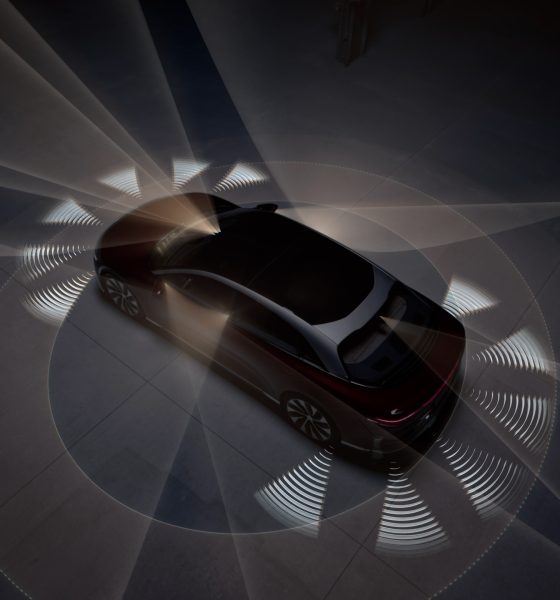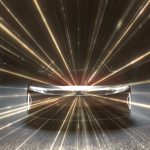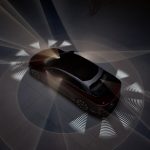

News
Lucid announces DreamDrive: a ‘user-friendly, future-ready’ Advanced Driver Assistance System
Lucid Group has announced the details of its Advanced Driver Assistance System (ADAS), DreamDrive, which it calls “the most technically sophisticated advanced driver-assistance system.” Lucid’s DreamDrive, which comes standard in the company’s top two trims of its Air sedan, employs up to 32 onboard sensors, a driver-monitoring system, and a user-friendly interface powered by onboard ethernet networking systems. The system is set to have new features and improvements delivered to it through a series of Over-the-Air updates.
“DreamDrive Pro has been designed to grow in capability, thanks to our ability to deliver software over-the-air and key equipment already in place in the vehicle,” Lucid’s Senior Director of ADAS and Autonomous Driving, Dr. Eugene Lee, said. “Thanks to highly integrated hardware and software teams, Lucid has the ability to develop new functionality for DreamDrive Pro in-house. This can benefit every facet of the DreamDrive Pro experience, from the frequency of updates to the planned rollout of the Highway Pilot system for conditional automated driving on select roadways in the coming years.”
Lucid Air Dream gets massive 520-mile range rating in preliminary EPA tests
A Sensor Suite That Can Detect What the Human Eye Cannot
The 32 onboard sensors that will feed data to the DreamDrive system will detect what the human eye can’t. Only the most trained eye will be able to spot the up to 32 sensors on the Air Dream and Grand Touring editions as they will be seamlessly integrated into the exterior of the sedan.
Lucid writes:
“Comprising 14 visible-light cameras, five radar units, four surround view cameras, ultrasonic sensors throughout the vehicle exterior, and, for DreamDrive Pro, the first automotive installation of LIDAR in North America. This solid-state LIDAR sensor will deliver high-resolution data with an ultra-wide field of view. Together, these sensors enable DreamDrive to detect what a human driver cannot, and act as an invisible co-pilot to help drivers get to their destination safely.”
- Credit: Lucid
- Credit: Lucid
- Credit: Lucid
- Credit: Lucid
A Human-Machine Interface That’s About the Human
Lucid DreamDrive also will use its Surreal Sound from its 21-internal speaker system to deliver clear directional alerts that will enhance the safety and awareness of drivers. The use of the speakers to warn drivers with directional alerts will enhance features like Front and Rear Cross Traffic Protection and Autonomous Emergency Braking. Surround View Monitoring also will provide a 360-degree view of the car, helping maneuver tight parking spaces or streets.
Highway Assist and Auto Park
Highway Assist and Auto Park features will also help enhance DreamDrive’s versatility. Lucid writes regarding Highway Assist:
“The Highway Assist group of features is designed to help drivers stay safe, while also making the Lucid Air even more delightful to drive. Highway Assist blends adaptive cruise control and lane centering control to help keep the Lucid Air right where it belongs on the freeway, at a safe distance from the vehicle ahead and other lanes. Traffic Jam Assist operates at speeds between 0 and 40 miles per hour, aiding in centering the vehicle when lane lines are occluded by close traffic. For vehicles equipped with DreamDrive Pro, further functions for Highway Assist are already in development.“
Of course, drivers will be able to use Highway Assist when the driver is attentive, and this will be confirmed through a robust sophisticated driver monitoring system. “An infrared driver camera tracks head position, eye gaze, and blinking, while hands-off detection prompts the driver to return their hands to the steering wheel immediately,” the company’s press release states.
Additionally, an Auto Park feature will make putting the car in tight spots much easier. Identifiying parallel or perpendicular spots and easily parking in them makes the task of maneuvering a thing of the past. It will even turn the wheels toward or away from the curb when parking on a hill.
A Robust Platform for Greater Capability in the Future
All of these features are great, but they wouldn’t be possible without the right platform. Lucid’s proprietary Ethernet Ring will enable four high-speed computer gateways – one at each corner of every vehicle – which will communicate with one another at lightning-fast speeds to result in high performance and hgih degrees of redudnancy for key ssytems like steering, braking, power, sensors, and more.
What do you think? Let us know in the comments below, or be sure to email me at joey@teslarati.com or on Twitter @KlenderJoey.

Elon Musk
Elon Musk and Tesla AI Director share insights after empty driver seat Robotaxi rides
The executives’ unoccupied tests hint at the rapid progress of Tesla’s unsupervised Robotaxi efforts.

Tesla CEO Elon Musk and AI Director Ashok Elluswamy celebrated Christmas Eve by sharing personal experiences with Robotaxi vehicles that had no safety monitor or occupant in the driver’s seat. Musk described the system’s “perfect driving” around Austin, while Elluswamy posted video from the back seat, calling it “an amazing experience.”
The executives’ unoccupied tests hint at the rapid progress of Tesla’s unsupervised Robotaxi efforts.
Elon and Ashok’s firsthand Robotaxi insights
Prior to Musk and the Tesla AI Director’s posts, sightings of unmanned Teslas navigating public roads were widely shared on social media. One such vehicle was spotted in Austin, Texas, which Elon Musk acknowleged by stating that “Testing is underway with no occupants in the car.”
Based on his Christmas Eve post, Musk seemed to have tested an unmanned Tesla himself. “A Tesla with no safety monitor in the car and me sitting in the passenger seat took me all around Austin on Sunday with perfect driving,” Musk wrote in his post.
Elluswamy responded with a 2-minute video showing himself in the rear of an unmanned Tesla. The video featured the vehicle’s empty front seats, as well as its smooth handling through real-world traffic. He captioned his video with the words, “It’s an amazing experience!”
Towards Unsupervised operations
During an xAI Hackathon earlier this month, Elon Musk mentioned that Tesla owed be removing Safety Monitors from its Robotaxis in Austin in just three weeks. “Unsupervised is pretty much solved at this point. So there will be Tesla Robotaxis operating in Austin with no one in them. Not even anyone in the passenger seat in about three weeks,” he said. Musk echoed similar estimates at the 2025 Annual Shareholder Meeting and the Q3 2025 earnings call.
Considering the insights that were posted Musk and Elluswamy, it does appear that Tesla is working hard towards operating its Robotaxis with no safety monitors. This is quite impressive considering that the service was launched just earlier this year.
Elon Musk
Starlink passes 9 million active customers just weeks after hitting 8 million
The milestone highlights the accelerating growth of Starlink, which has now been adding over 20,000 new users per day.

SpaceX’s Starlink satellite internet service has continued its rapid global expansion, surpassing 9 million active customers just weeks after crossing the 8 million mark.
The milestone highlights the accelerating growth of Starlink, which has now been adding over 20,000 new users per day.
9 million customers
In a post on X, SpaceX stated that Starlink now serves over 9 million active users across 155 countries, territories, and markets. The company reached 8 million customers in early November, meaning it added roughly 1 million subscribers in under seven weeks, or about 21,275 new users on average per day.
“Starlink is connecting more than 9M active customers with high-speed internet across 155 countries, territories, and many other markets,” Starlink wrote in a post on its official X account. SpaceX President Gwynne Shotwell also celebrated the milestone on X. “A huge thank you to all of our customers and congrats to the Starlink team for such an incredible product,” she wrote.
That growth rate reflects both rising demand for broadband in underserved regions and Starlink’s expanding satellite constellation, which now includes more than 9,000 low-Earth-orbit satellites designed to deliver high-speed, low-latency internet worldwide.
Starlink’s momentum
Starlink’s momentum has been building up. SpaceX reported 4.6 million Starlink customers in December 2024, followed by 7 million by August 2025, and 8 million customers in November. Independent data also suggests Starlink usage is rising sharply, with Cloudflare reporting that global web traffic from Starlink users more than doubled in 2025, as noted in an Insider report.
Starlink’s momentum is increasingly tied to SpaceX’s broader financial outlook. Elon Musk has said the satellite network is “by far” the company’s largest revenue driver, and reports suggest SpaceX may be positioning itself for an initial public offering as soon as next year, with valuations estimated as high as $1.5 trillion. Musk has also suggested in the past that Starlink could have its own IPO in the future.
News
NVIDIA Director of Robotics: Tesla FSD v14 is the first AI to pass the “Physical Turing Test”
After testing FSD v14, Fan stated that his experience with FSD felt magical at first, but it soon started to feel like a routine.

NVIDIA Director of Robotics Jim Fan has praised Tesla’s Full Self-Driving (Supervised) v14 as the first AI to pass what he described as a “Physical Turing Test.”
After testing FSD v14, Fan stated that his experience with FSD felt magical at first, but it soon started to feel like a routine. And just like smartphones today, removing it now would “actively hurt.”
Jim Fan’s hands-on FSD v14 impressions
Fan, a leading researcher in embodied AI who is currently solving Physical AI at NVIDIA and spearheading the company’s Project GR00T initiative, noted that he actually was late to the Tesla game. He was, however, one of the first to try out FSD v14.
“I was very late to own a Tesla but among the earliest to try out FSD v14. It’s perhaps the first time I experience an AI that passes the Physical Turing Test: after a long day at work, you press a button, lay back, and couldn’t tell if a neural net or a human drove you home,” Fan wrote in a post on X.
Fan added: “Despite knowing exactly how robot learning works, I still find it magical watching the steering wheel turn by itself. First it feels surreal, next it becomes routine. Then, like the smartphone, taking it away actively hurts. This is how humanity gets rewired and glued to god-like technologies.”
The Physical Turing Test
The original Turing Test was conceived by Alan Turing in 1950, and it was aimed at determining if a machine could exhibit behavior that is equivalent to or indistinguishable from a human. By focusing on text-based conversations, the original Turing Test set a high bar for natural language processing and machine learning.
This test has been passed by today’s large language models. However, the capability to converse in a humanlike manner is a completely different challenge from performing real-world problem-solving or physical interactions. Thus, Fan introduced the Physical Turing Test, which challenges AI systems to demonstrate intelligence through physical actions.
Based on Fan’s comments, Tesla has demonstrated these intelligent physical actions with FSD v14. Elon Musk agreed with the NVIDIA executive, stating in a post on X that with FSD v14, “you can sense the sentience maturing.” Musk also praised Tesla AI, calling it the best “real-world AI” today.












